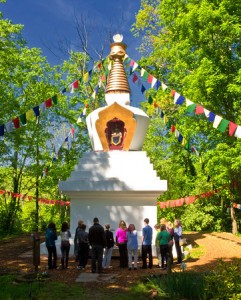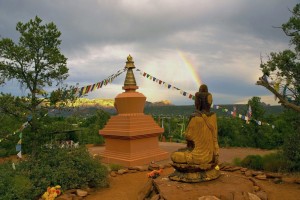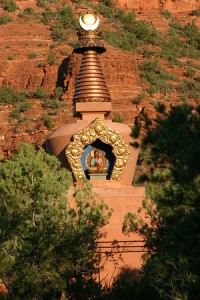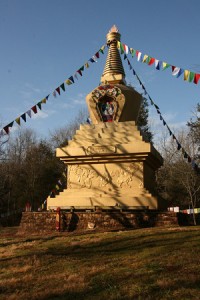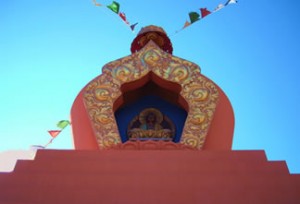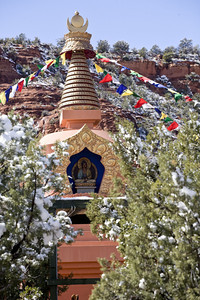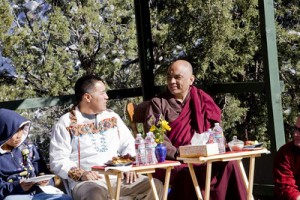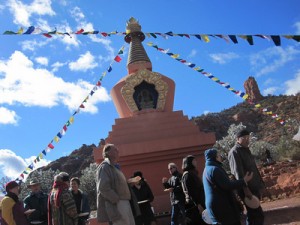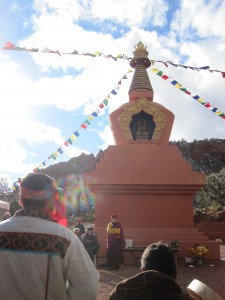The following is a full length video teaching by Tulku Sang Ngag Rinpoche on the different types of Stupas offered at Kunzang Palyul Choling:
sacred objects
Compassionate Blessings: A Dialog
The following is from a twitter dialog between Jetsunma Ahkon Lhamo and one of her followers:
Stupas cost about $150K -200K to build including the required Stupa Master. It boggles that people with that kind of money don’t support Stupa building for peace, to pacify suffering, sickness and old age, delay death, pacify war and hunger, and balance the planet. That’s why we should build Stupas.
(Jetsunma asks follower how he is doing.)
Follower: Happy as a clam and fit as a fiddle, lovely one. Your pretty little self?
Jetsunma: Not too shabby even though I had a hopeful ring appraised to build a Stupa. It was a total flat out fake. Gotta fund raise. Fund raising is kind of embarrassing, but its for an excellent reason. We’ll figure it out. Stupas are worth it. If there was anything else worth it I’d give it up in a heartbeat.
Follower: Well, it could be argued that raising the funds for those in need takes precedent, which is, to an extent true.
Jetsunma: I have built Stupas already, over 30, want to build them anywhere there is suffering and hardship or war.
Follower: Good for you, angel. I’m not suggesting you shouldn’t. I spend part of my time raising money to keep a 13th century building up.
Jetsunma: To me and mine this is the best way to give to all, blessings bring result. What kind of blessing? For example, a tumor dissolves, and no money for medical costs. It’s a “vibrational” blessing, sphere of truth. Love. Like a Buddha.
Follower: What about the poor and needy? If only life where black and white, eh?
Jetsunma: And you are right. Its not black or white: compassion. And we do a food bank, animal rescue, we work for the benefit of all. Here’s a teaching offered by a Master Stupa builder on the blessings they bring https://www.tibetanbuddhistaltar.org/the-merit-of-stupa-building/. Thing is you can argue and such but this is what I do, charity and benefit are my reason for being.
Copyright © Jetsunma Ahkon Norbu Lhamo All rights reserved
Follower:
Precious Jewels
The following is from a series of tweets by Jetsunma Ahkon Lhamo:
If someone gave you a very expensive piece of old jewelry what would you do with it? I’d build another stupa. A gift to the earth and all beings.
Why wear something so valuable when it can benefit beings? It will bless everything and anyone for atleast 100 miles in all directions. Of course we can raise money. But if this ring is real, I wish to pay for it all myself. I pray it is real so I have the privilege to help beings.
When the time comes we will ask for volunteers and I hope many will use this tremendous opportunity to gather merit and clear non-virtue.
Copyright © Jetsunma Ahkon Norbu Lhamo All rights reserved
The Power of Stupas 2: Tulku Sang Ngag Rinpoche (VIDEO)
The following teaching by Tulku Sang Ngag Rinpoche was recorded live at Kunzang Palyul Choling in Maryland:
What Is a Stupa?
A Video teaching by Jetsunma Ahkon Lhamo
Blessings for All
The following is from a series of tweets by Jetsunma Ahkon Lhamo:
As you know KPC held a fabulous Web-A-Thon in Sedona for the Palyul Stupa and it was a great success, we have money for the Stupa land. And we’re still going. Sedona wants the Stupa kept as well and has helped us a lot. The value of the Stupa is becoming familiar to all. Really, something so precious yet exotic in this land is something special! Like a wish fulfilling gem it heals all.
When a Stupa is present the power is enormous and benefits all who do pilgrimage there. Please do visit!
Also we are steadily working on the Migyur Dorje Stupa to do cosmetic repair. We hope you will also do pilgrimage here. They are powerful and enormous!
On temple grounds we also have an Enlightenment Stupa for all to make progress on our path. Blessings for all.
Bring the sick, the needy and they will be blessed. Just get here! Even my doggie Rickey is getting better! There was no hope and here he is!
Copyright © Jetsunma Ahkon Norbu Lhamo. All rights reserved
Incalculable Benefit of Stupas: Excerpt from Lama Zopa
The following is an excerpt from “The Benefits and Practices related to Statues and Stupas” by Lama Zopa Rinpoche
The conclusion for Buddhists and non-Buddhists alike is that the stupa is a way to purify defilements. A holy stupa is a way to benefit sentient beings without words. It will liberate beings from samsara in silence. To have such a holy object existing in a country makes it very rich and very lucky. Many people will come to visit for pleasure as tourists, but it will at the same time make their life meaningful. The most important point is that holy objects help beings to purify their mind and to collect extensive merit so that it is possible for them to easily have realizations of the path. That is the main function of these holy objects – to help us sentient beings have quick realizations of the path to enlightenment by the power of the holy object.
Those who build and work to actualize those holy objects will bring these beings to enlightenment. So anyone who sees it, touches it, remembers it, even dreams of it will have the seed planted for their own enlightenment. As well, prostrating and so on to the stupa helps bring them to enlightenment. By have the Secret Relic mantra within the stupa, any animals, ants, butterflies, etc. that go around the stupa even just once are purified of their negative karma to be born in the hot hells.
Even if we all die, as long as the holy objects that we have created last, our work, our effort [to create holy objects], is still benefitting sentient beings continuously. For all the many hundreds and thousands of years that the stupa will last, every day it will liberate sentient beings in silence…without words…without our talking Dharma to them. You see, just by seeing the stupa, the minds of of sentient beings who come here get purified. So many negative karmas get purified. Even the insects who are killed by machines during the construction – even they will not be reborn in the lower realms. Even those that die during the building process will receive a good rebirth. It is mentioned by a great Indian teacher in a text calledMatasara, or something like that, that even if you make food for the people building the temple, your negative karma will be purified.
Let the Circle Be Unbroken
At the invitation of Jetsunma Ahkön Lhamo, Khenpo Tenzin Norgay was in Sedona the weekend of February 25-27 for several events, including an Amitabha empowerment at KPC’s Amitabha Stupa, several talks on the significance of the stupa and the sacred land upon which it is built, and even a guest appearance at the Sedona International Film Festival to answer questions at the screening of a documentary movie called Journey from Zanskar: A Monk’s Vow to Children. The weekend’s events were a great success, drawing large audiences despite the chilly February weather and the competition of the film festival. But the event at the stupa on Sunday, February 27th, provided a special treat to those who braved the elements.
Sunday – Dakini Day – dawned to a world of white with fluffy fresh snow blanketing the town and the red rocks. Such a snow is considered a blessing by Tibetans, but it seemed an inauspicious start to a day that was planned to feature a talk by Khenpo at the stupa and a song offering by Hopi Indians. It appeared that the Hopi would not be able to make it to Sedona as all roads leading from the Flagstaff area were closed. In addition, the wet, rapidly melting snow had turned the dirt road leading up to the stupa into a quagmire. This meant that no vehicles would be able to drive to the stupa to carry heavy equipment like a PA system or a generator to power the planned webcast. In view of the situation, it was decided to change the schedule and replace the planned talk with a Shower of Blessings practice, which is the heart practice at KPC, and including a sang (smoke) offering to purify negativity.
By 2:00 the warm sun had melted much of the snow, and the clouds had long since abandoned the sky to the brilliant Arizona sun. A group of about thirty people had assembled, many of whom had never participated in any kind of Tibetan Buddhist practice. Partway through the practice, to everyone’s surprise, word arrived that the Hopis were indeed on their way and were expected shortly. The practice was speeded to finish by the time they arrived. As people were enjoying the food offering that is a part of the practice, Ruben Saufkie Sr. came walking up the hill with his two young sons. They were seated on the stage next to Khenpo, and Ruben and Khenpo talked for several minutes. People were invited to come and sit close to the stage, and Ruben then repeated what he had shared with Khenpo.
Ruben said that he personally had been out of balance for many years, caught up in the throes of alcoholism, disrespectful to everyone, out of control. But then he looked into the eyes of his children and recognized the same look of fear and hopelessness that he had experienced as a child, for both his father and grandfather had also been alcoholics. This realization caused him to reexamine his life as a father and as a Hopi. His Hopi elders gave him the teachings to help him overcome his addictions and to return to balance. As he emerged from his addictions, he also began to see how the Hopis as a tribe were also out of balance and that this was destroying them. The population has shrunk to a mere 13,000, and out of over a hundred clans, only less than thirty survive. Disagreements between individual Hopis and Hopi villages abound on how the Hopi nation should cope with the modern world. What Ruben came to realize was that Hopis should return to their original teachings of how to live life in balance, that they needed to move out of their egos and return to their hearts as this was the seat of power and balance.
Ruben’s mission now, as he explained, was to do everything he could to restore this balance, both in the Hopi nation and the world. He said he began with his own life and family, and that he was now reaching out to his fellow Hopi and to those beyond the reservation. This has often resulted in attacks by other Hopis, accusing him of just pursuing money, consorting with non-Hopis, and not caring about his people. Ruben said that this has been very painful for him and there have been times when he has felt like abandoning his mission. When he received the invitation to come to Sedona to participate in the events with Khenpo, however, he felt like a new door had been opened, and his enthusiasm to continue was renewed. On Sunday morning he saw the snow and heard the traffic reports, but he felt certain that this meeting was meant to happen, so he set out. As he and his sons approached Flagstaff, a pure white hawk flew directly over his car, so he felt certain that everything would be auspicious. And indeed, I-17 was reopened by the time he got to Flagstaff, and he was able to safely drive down the mountain to Sedona.
Ruben then talked about the location of the stupa and explained how this area had been known to his people long ago. They thought it was extraordinarily beautiful, but they chose not to live there because they knew that someday someone would take the land from them for its beauty. After a short stay, they proceeded on their way to their permanent home on the Hopi Mesas, which are shaped like a hand. He said that building a stupa in this place is a wonderful way to honor its sacredness.
Then Ruben and his sons donned their traditional Hopi dress and prepared to sing. First Ruben blessed the stupa, Khenpo, and the audience with condor and eagle feathers, representing the 500 year-old prophecy of the coming together of the ancient teachings of the North (eagle) with those of the South (condor) – in other words, the joining of the ancient wisdom of the Indian tribes of the North, such as the Hopi, with those of the South, the Incas, Aztecs, Mayas. Then he and his sons formally introduced themselves, first in Hopi, then in English. They proceeded to sing several traditional Hopi songs dedicated to bear, deer and other native animals, accompanied by drum and rattle. The songs evinced the beauty of the high windswept mesas where the Hopi found their permanent home, evoking a feeling of ancient wisdom and a connection to the earth that has been largely lost in our modern, hyperactive world.
Several photographs taken at the time of the songs reveal miraculous images of rainbow light and bindus – small orbs of energy which, according to Khenpo (who took the picture seen here), are signs of the auspiciousness of the two traditions coming together. Jetsunma, who followed the day’s events closely via texting and photographs, added, “Here are two Ancient Tribes returning.” She went on to say, “This is so auspicious!!! I cannot tell you!”
The ancient prophecies are coming true before our eyes. EH MA HO!
This article was written by Thubten Palzang
Bell and Dorje
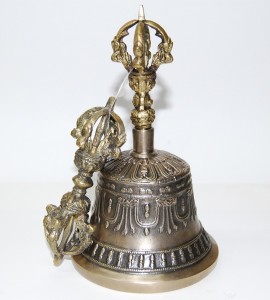
By Rinchen Khandro
In Vajrayana Buddhism there are ritual implements and instruments. Many of the Buddha images hold one or two, or many of these, depending on how many arms the particular Buddha is displaying. All of these implements have meaning. Each is there to engage our busy minds in a way that will lead us toward the Truth. Those held in the left hand relate to wisdom, the realization of the emptiness of all phenomena, and those held in the right hand relate to skillful means, or compassion.
The bell and dorje are two of these implements. The dorje, held in the right hand, represents skillful means, and the bell, held in the left, represents wisdom. Together these ritual implements represent the inseparability of wisdom and compassion in the enlightened mindstream. Looked at separately, each is a great treasure of spiritual meaning.
The word Dorje means Lord of Stones in Tibetan. It symbolizes the capacity to transform all experience into an experience of enlightened perspective. Everything in samsara, cyclic existence, is impermanent, and therefore, not to be relied upon. The dorje symbolizes the skillful means of transforming our ordinary experience to one that will propel us on our spiritual path. The dorje has five extraordinary characteristics. It is impenetrable, immovable, immutable, indivisible, and indestructible. The dorje is the indestructible weapon of the wrathful deities. It is the symbol of spiritual authority of the peaceful deities.
Vajra, the Sanskrit word, means the hard or mighty one, diamond-like. Its brilliance illuminates ignorance and reveals Truth, destroying the delusion that causes suffering. Once the cause of suffering is revealed to us, we are empowered to create the causes of happiness. Ultimately we will attain the egoless state, which is free from all suffering. From the Vajrayana perspective, the motivation for attaining this state is to relieve all beings from their suffering.
The physical appearance of the dorje is rich in meaning. At the very center is a sphere representing the dharmata, the sphere of reality itself, the ultimate truth. Surrounding the sphere on either side are one or three ‘strands of pearls’, depending on the size of the dorje. These represent the three doors of liberation. The first door is the transcendental concentration of signlessness, in which words and concepts fall away and there is nothing to grasp. The second is the transcendental concentration on directionlessness, the state of perfect equanimity–spiritual stability and balance. The third is the transcendental concentration on emptiness.
Next to the pearls on either side of the sphere are eight-petaled lotuses. The petals on one side represent the eight great Bodhisattvas; the petals on the other represent their consorts. * The next display on the vajra is a moon disc. This is the seat of the Bodhisattvas symbolizing the full realization of Bodhicitta, the Great Compassion.
There are six more rings after the moon disc. These symbolize the six perfections: generosity, moral conduct, patience, joyful effort, concentration, and wisdom. The accomplishment of these six is the foundation of the Mahayana, the Great Vehicle of Buddhist study and practice. They are the hallmark of the Bodhisattva path. When one has accomplished these, one can truly be of benefit to others.
The next thing we see on the dorje are the makaras. A makara is a composite animal with jaws like a crocodile which symbolizes effort and persistence in Dharma practice.
A vajra may have one, two, three, four, five, six, or nine prongs. The most common is the five-pronged vajra. They look like points that protrude from the curved ends, one on each curve and one at each end. These five prongs symbolize the five Buddhas of the five Buddha families and their consorts.
The bell, also, is rich in symbolic meaning and power. Mainly the bell is the mandala of Prajnaparamita, the Great Mother, she from whom all reality comes forth. By its sound, the bell invites or attracts the deities to attend or participate and warns or drives away obstructing forces. The ringing of the bell can remind one of the emptiness of phenomena or bring the mind into greater awareness. As a musical instrument, its sound can be an offering to the Buddhas and Bodhisattvas.
The hollow of the bell represents the void from which all phenomena arise, including the sound of the bell, and the clapper represents form. Together they symbolize wisdom (emptiness) and compassion (form or appearance). The sound, like all phenomena, arises, radiates forth and then dissolves back into emptiness.
If you look closely at the bell, you will see many markings or designs on it. Each of these has a meaning. On the rim of the bell is the disc of space that gives rise to the sound of emptiness. The vajra fence, the indestructible circle of protection which encircles the bell is bordered on both sides by a ring of pearls. The bottom ring is a ring of wisdom flames, representing the five primordial wisdoms. The top ring of pearls is another protective circle symbolizing the development of the higher states of consciousness which allow one to enter the celestial palace of Prajnaparamita. The flames are associated with Manjushri, the Bodhisattva of Wisdom, the vajras with Vajrapani, the Bodhisattva of Power, and the lotuses with Chenrezig, the Bodhisattva of Compassion. This indicates that spiritual qualities are the true protection.
Above the protective border are the makaras holding loops of jeweled pendants with vajras in between them. The jeweled pendants decorate the celestial palace. The vajras in between symbolize the eight charnel grounds within the mandala. Above the jeweled loops and between the makaras are eight lotus petals representing the eight Bodhisattvas. The lotus petals are marked with syllables representing the eight consorts or offering goddesses. Above this is another double row of pearls with a row of vajras in between. These represent the inner walls and inner protection circle of the mandala.
The stem of the bell rises above this. At its base are lotus petals, representing Prajnaparamita’s lotus throne. On the stem there are two sets of pearl rings, a lower set and an upper set. Together these represent the six perfections. In between them is either a square or round base. The square base represents the earth, the round a long life vase. The long life vase symbolizes the nectar of accomplishment and represents the nectar-filled body of the goddess Prajnaparamita whose face is above. Prajnaparamita represents the perfection (paramita) of the absolute non-duality of all the Buddha’s wisdom or discriminating awareness (prajna). The binding of her hair represents the binding of all views into non-dual reality. There are five wisdom-jewels on her crown, which overlap onto the five front petals of the upper vajra’s eight-petaled lotus pedestal. The bell is crowned at the top with a five or nine-pointed vajra.
These two instruments give us much to contemplate and meditate upon. Deepening in our understanding of what they represent and using them in our practice with that deepened understanding give them the potential of being very valuable tools for our path. As we become more familiar with the various Buddhas and their qualities, and participate in ritual ceremony and empowerment we move closer to the realization of our own Buddha nature, which is, after all, the point.
References:
Beer, Robert, 1999. The Encyclopedia of Tibetan Symbols and Motifs, Shambhala, Boston.
Vessantara, 2001.The vajra and bell, Windhorse Publications11 Park Road, Birmingham, B13 8AB.
_______________________
*The eight Bodhisattvas and their consorts are:
East: Kshitigarbha and his consort Lasya. She offers beauty and her syllable is Tam.
Southeast: Maitreya and his consort Pushpa. She offers flowers and her syllable is Mam.
South: Akashagarbha and his consort Mala. Her offering is garlands and her syllable is Lam.
Southwest: Samantabhadra and his consort Dhupa. Her offering is incense and her syllable is Pam.
West: Avalokithesvara and his consort Gita. Her offering is song and her syllable is Mam.
Northwest: Manjughosha and his consort Aloka. She offers light and her syllable is Tsum.
North: Vajrapani and his consort Nrit ya. She offers dance and her syllable is Pam.
Northeast: Sarva-nivarana-vishkambhim and his consort Gandha. She offers perfume and her syllable is Bhrum.
How to Make an Altar
Learn how to make your own Buddhist altar. Special thanks to Ananda Robie for the production of this video.
